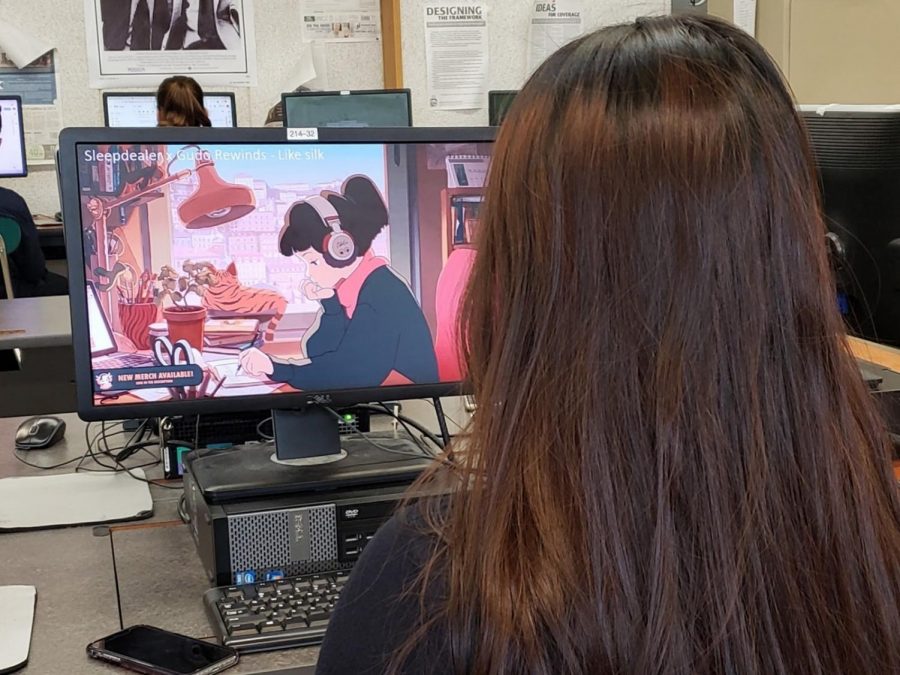Lo-fi Music: Where Low-Quality is the Aesthetic
Hyein Lee ’19 listens to the iconic Youtube video, “lofi hip hop radio – beats to relax/ study to” for the first time ever. “I don’t really listen to music when I study, but I think that the simple beat makes this type of music minimally distracting,” she said.
Have you watched that one video that YouTube keeps recommending? The one entitled “lofi hip-hop radio – beats to relax/ study to” on the channel ChilledCow? The one with an animated girl, flipping what seems like a never-ending stream of pages? This (in this case, lo-fi hip-hop) is a type of music that has been experiencing a popularity boom among people who want to relax, study, or listen for the sake of listening. But what really is lo-fi, and why is it suddenly so popular?
“I’d describe lo-fi as a subgenre of music that highlights a strong bass or beat with a simple, easy-to-get-stuck-in-your-head melody that repeats. It is most recognizable for its repetition and sound imperfections, but also for its use of heavy tones and sound effects from everyday life, such as the faint scratching of a needle across a record or the soft crashing of ocean waves,” said Phoebe Marbid ’21.
Lo-fi, in the context of music, literally means ‘sounds that seem of lower quality.’ This is one of the defining qualities of the music. The “fuzzy” sound can be soothing to the ears and serve as calming background music, which is ideal for studying.
“I usually listen to lo-fi when I’m studying for a big test and need something to play in the background that’s not as distracting as music that’s on the Billboard Hot 100 today,” said Janet Chen ’20.
Another ideal feature of lo-fi music is the repetition of simple beats. “I listen to lo-fi whenever I do repetitive tasks and to relax. Even when I just don’t have the energy to talk to anyone after a long day, I put on my headphones and listen to entire playlists of lo-fi,” said Marbid.
While lo-fi is an umbrella term that can be used to describe practically any music produced to mimic a lower sound quality, the word is often thrown around and incorrectly associated with other styles of music. For instance, “chillhop” and “jazzhop,” (chill-sounding music with a hip-hop beat, and jazz music with a hip-hop beat, respectively) are often used to for studying or relaxation, but are not synonymous with lo-fi music. In simple terms, chill-hop or jazz-hop are not necessarily lo-fi, but definitely can be. As previously stated, lo-fi, defined in technical terms, refers to the usage of certain effects that produce a sound that mimics lower quality. Therefore someone can create rock music that is lo-fi, or jazz music that is lo-fi (called lo-fi rock and lo-fi jazz, respectively.) Likewise, chill-hop can be lo-fi, but does not necessarily have to be. Chill-hop alone is electronic music characterized by mellow, softer, and slower beats. Chill-hop can even be hi-fi (of high sound production quality) but of course, that does not create the same distinct auditory aesthetic as lo-fi production does.
“As a musician, I believe that music is what it is not because of how simple or complex its beats and melody are, but because of the connection that it creates with its listeners,” said Phoebe Marbid ’21.
The sudden popularity of lo-fi has prompted inquiries into the causes of such a drastic increase in listeners. As one Reddit user put it, “Is it me or has lo-fi been gaining popularity the past couple months?” Like any other “boom” in the elusive world of modern-day art and culture, the exact mechanisms are largely unknown. Yet it can be conjectured that lo-fi’s usability as study music, as well as availability through popular streaming sites such as YouTube makes it especially popular with young people.
There has been much debate on the credibility of lo-fi music as “real music.” Considering the rather simple anatomy of most lo-fi pieces, it is no surprise that many listeners try to create their own lo-fi. Some people argue that this mass production takes musical meaning away from the piece. Others argue that lo-fi still retains integrity as an art form.
“Music itself is an elusive idea, so with that in mind, lo-fi can count as music. Yes it has repeating beats and background noise but that doesn’t mean that it’s any less enjoyable to listen to as entertainment,” said Chen ’20.
“As a musician, I believe that music is what it is not because of how simple or complex its beats and melody are, but because of the connection that it creates with its listeners. Rock music in the 1950s catered to the relevance of teenage rebellion. Disco music during the same time was the solace of minorities facing oppression,” said Marbid. “Lo-fi music now, as I see it, caters to the generation of young people who just want to relax from the stresses of a tense and uncertain world situation.”
Angie Yang is an Editor-in-Chief of ‘The Observatory’ and a Staff Reporter for ‘The Science Survey.’ This is her second year in Journalism. She...











